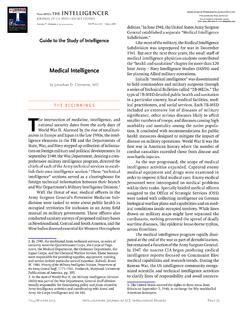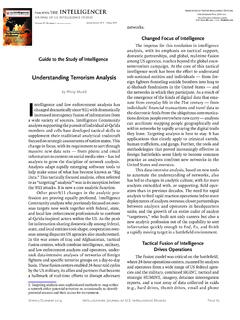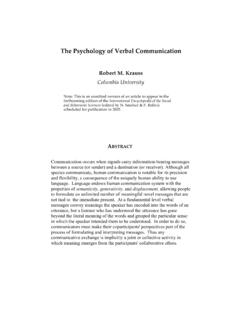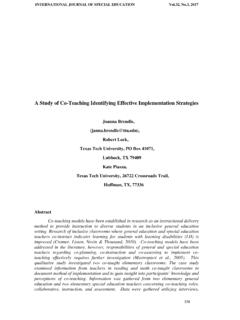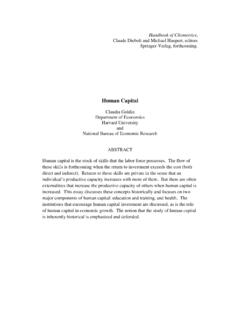Transcription of Perspectives on Intelligence Collection - AFIO
1 Page 47 Intelligencer: Journal of Intelligence StudiesFall/Winter 2013 Guide to the Study of IntelligencePerspectives on Intelligence Collectionby robert M. clark , PhDINTRODUCTIONI ntelligence is collected in many ways from spies, eavesdropping, technical sources, and openly available materials. The various means are tradi-tionally described as Intelligence disciplines or, in shorthand, INTs. The term INT, however, has also been applied to a few specialized analysis disciplines, resulting in some confusion: is a concept having an INT suffix a Collection INT, or an analytic method?How you view the Intelligence Collection INTs depends on where you sit. Collectors have a specific view of the Collection function, structure and pro-cess. And for them, it makes sense. It follows the US Intelligence communit y organization. Analysts, to do their jobs most effectively, need to take a different perspective, one that is not closely tied to the existing functional or structural divisions.
2 Let s examine those views, starting with VIEW: THE COLLECTOR S AND ANALYST S PERSPECTIVESThe traditional and easiest to understand view of Collection divides the sources up by following the existing organizational structure. For the , this results in the breakout shown in Figure 1. For a Collection manager, Figure 1 is the simplest and most logical way to view the functions performed by Collection . So we have large Collection organizations such as the National Geospatial- Intelligence Agency (NGA) responsible for imagery (IMINT) Collection , and the National Security Agency (NSA) responsi-ble for signals Intelligence (SIGINT). These are the stovepipes that Intelligence professionals know well. Though they make collaboration difficult, stovepipes serve a number of essential sometimes refer to these as cylinders of excellence , which provides a clue as to how the divisions developed historically and a reason to func-tionally view them through that lens.
3 Each stovepipe has built a critical mass of expertise, an elite force that its members consider to be the best in the world at what they do. Another reason that the stovepipe structure works well for collectors is that it identifies the functional managers of the major Collection INTs. Functional managers have the job of protecting equi-ties. They must plan for Collection and define the areas of responsibilit y for the various , functional managers must ensure that the entire Collection process is effectively and efficiently managed, and they must argue their case for budget dollars each Figure 1 is the simplest and most logical way to view the functions performed by Collection , there is Figure 1: Collector s Functional View of Intelligence CollectionFrom AFIO's The Intelligencer Journal of Intelligence StudiesVolume 20 Number 2 $15 single copy priceAssociation of Former Intelligence Officers 7700 Leesburg Pike, Suite 324 Falls Church, Virginia 22043 Web: , E-mail: Fall/Winter 2013 2013, AFIOPage 48 Intelligencer: Journal of Intelligence StudiesFall/Winter 2013another way to view Collection functionally, shown in Figure 2.
4 It s important to understand the difference, because it shapes how analysts can best collaborate with collectors and deal with type of Collection produces literal informa-tion. It s the form that we use for everyday communi-cation. Analysts understand how literal Intelligence is collected and used. It requires no special exploitation after the processing step (usually just language trans-lation) to be understood. It literally speaks for information, in contrast, usually requires expertise in special processing and exploita-tion in order for analysts to make use of it. Most cus-tomers don t understand it. British author Michael Herman also has written that there are two basic types of Collection . He describes the types on the left as Access to human thought processes and the types on the right as Observations and measurements of t h i n g s . 1 There are at least a few reasons for thinking this way about Collection as an analyst.
5 First, analysts request the types of Collection that they need, without a focus on where the Collection actually comes from or which specific organization it resides in. Though Figure 1 identifies the functional manager for each type of Collection , it doesn t accurately describe where Collection actually occurs. DIA and the mili-tary services collect more HUMINT than CIA does, and the State Department is a key HUMINT provider (although diplomatic reports are not officially termed 1. Michael Herman, Intelligence Services in the Information Age (New York: Frank Cass Publishers, 2001), 82. Intelligence ). NSA collects MASINT signals. All the organizations in Figure 1, and several others, collect open literal and non-literal Collection are essen-tial, of course. But, a second reason analysts use this functional delineation is that the two have to be judged differently. For example, literal Intelligence can help determine intent and do predictive anal-ysis, while non-literal Collection usually cannot.
6 A weakness of literal Collection , though, is that people are less reliable than the scientific measurements collected non-literally. People may be misinformed or lie. During World War II, General Rommel lied to Berlin about being short of supplies. The British, intercepting Rommel s communications, mistakenly believed him and attacked. Saddam Hussein s generals routinely lied to him about their capabilities, and he in turn lied to them about having weapons of mass destruction (WMD).Third, when making an assessment, analysts have to be wary of literal and non-literal specific biases. In literal Collection , they must rely on translators. For non-literal, they must rely on the processor or exploit-er s judgment. Customers sometimes receive and tend to act on raw literal Collection , because they can readily grasp it. That is not necessarily a good thing, because they are not trained analysts. But this functional view helps them see where they may be able to give input and where they may not challenge the Collection .
7 Inter-preting a hyperspectral image or an ELINT recording isn t usually within a customer s skill 2: Analyst s Functional View of Intelligence CollectionPage 49 Intelligencer: Journal of Intelligence StudiesFall/Winter 2013 TWO VIEWS OF THE PROCESS:The Intelligence Collection process is typically portrayed as a one cycle loop: question in, answer out. Figure 3 illustrates what the inside of a stovepipe looks like. It makes a nice picture but does not convey what is actually happening. Instead, Collection is a highly iterative and continuous process. Collectors jump around a lot in the diagram of Figure often refer to the front end and back end of the process, as indicated. And Figure 3 also illustrates what they mean. In this view, the cycle divides into three distinct stages: Requirements and Tasking are the front end. Collection is the middle action. And processing, exploitation and dissemi-nation are referred to as the back end.
8 In an ideal system, you d then identify the gaps in knowledge, revise the requirements, and the process begins s easy to think of it as a straight line process with a beginning and an end, rather than a cycle. That s how it works in practice. How you get from dissemination to requirements is almost an unknown for collectors. That s because they typically have no control over that step. Someone else has to do it. Usu-ally, that s the job of an s another way to think about both collec-tion structure and process, as shown in Figure 4, that is more useful for analysts. This view treats Collection as many separate stovepipes, each having a specialized variant of the process shown in Figure 3, and each producing a different type of Intelligence product therefore, having a different function. It also has two distinctly different products:Much of Collection is high volume, with auto-mated processing and of a mass of material which then is disseminated widely.
9 In the field, you get a lot of open source, IMINT and SIGINT without having to ask for other kind is often called targeted Collection ; I often describe it as boutique Collection . Think of the contrast between a mass-market store such as Wal-Mart and a boutique such as Tiffany s that caters to a select customer set. Targeted Collection is usually expensive, produced in small quantity for a few customers. It requires extensive processing and Collection INTs shown in blue are targeted. Those shown in gold-orange are usually mass collec-tion, but sometimes are targeted. ELINT is an exam-ple: it can be either (operational ELINT is mass col-lection; technical ELINT is targeted). Cyber Collection often is targeted, but much of it is mass is this important for analysts? Because they handle Collection requests quite differently, depend-ing on which type they are dealing with. Mass collec-tion typically has a formal requirements structure.
10 Imagery Collection , for example, may have mas-sive target Getting your target into those decks means navigating a formal requirements structure. In contrast, targeted collec-tion tends to be focused on a single event, facility, or individual. Think here of the hunt for Osama bin Laden or of Collection against a North Korean ballistic mis-sile test. Analysts tend to become much more directly involved in targeted Collection than in mass s also valuable for both analysts and collec-tors to view Collection structurally as Figure 4 (see next page) shows it, because the cultures are dif-ferent within each box shown in the figure. ELINT, FISINT, and COMINT are lumped within the cat-egory SIGINT in Figure 1. But these three INTs have distinctly different cultures, different technical 2. A target deck is a list of existing Intelligence targeting re-quests and the target related 3: Collector s Process ViewPage 50 Intelligencer: Journal of Intelligence StudiesFall/Winter 2013disciplines, and different security compartmentation practices.
